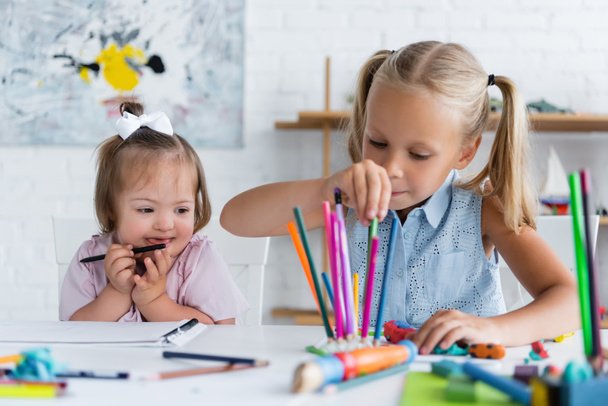Children thrive when they engage in activities that allow them to explore, create, and think
independently. Hands-on activities—those that involve doing rather than passively
observing—are powerful tools for promoting both cognitive and emotional development in kids.
Whether it’s crafting, building, or problem-solving, these interactive experiences are much more
than just fun; they play a pivotal role in shaping life skills, critical thinking, and creativity.
This blog will explore how hands-on activities fuel development in children, the various benefits
they bring, and how parents and caregivers can incorporate them into daily routines.
The Benefits of Hands-On Activities For Kids
Enhanced Cognitive Development
When kids participate in hands-on activities, they use their brains in unique ways. Activities like
puzzles, STEM experiments, or crafting stimulate both the left and right hemispheres of their
brains.
For example, constructing a tower with building blocks encourages spatial awareness and
problem-solving. Each block placed is a chance for kids to test out balance, structure, and
design. Similarly, science experiments teach cause and effect, further enhancing their
understanding of the world around them.
Boosted Creativity
Art projects, such as painting or molding with clay, allow children to express feelings, tell stories,
and think outside the box. Hands-on activities like these nurture imagination and creative
thinking, which are crucial for innovation and adaptability later in life.
Creativity isn’t limited to art activities either. Even unstructured activities like playing with sand or
water can result in imaginative stories and ideas, helping kids connect with their inner creativity.
Improved Social And Emotional Skills
Group-based hands-on activities, such as a collaborative art project or team-building games,
teach essential social skills like cooperation and communication. Kids learn to share, respect
different viewpoints, and work as part of a team—all critical skills for adulthood. Creative play
also provides a healthy outlet to express and manage emotions, aiding in emotional intelligence
development.
Stronger Motor Skills
Fine and gross motor skills are actively honed through hands-on activities. Manipulating small
objects like buttons or crayons strengthens kids’ fine motor abilities, preparing them for tasks
like writing. Gross motor activities, such as gardening or playing with larger toys, improve
coordination and physical strength.
For instance, at a local daycare in Taylorsville, teachers incorporate activities like threading
beads or planting seeds into their curriculum to promote both fine and gross motor skill
development.
Encouragement of Independent Learning
Hands-on activities often involve an element of discovery and problem-solving. This approach
encourages kids to think independently. They learn how to approach challenges in innovative
ways, boosting their confidence as they solve problems without relying heavily on adults for
guidance.
Take LEGO projects, for example. While kids might receive initial guidance, they decide the final
look of their creation, fostering a sense of initiative and decision-making.
How Parents and Teachers Can Implement Hands-On Activities
Create DIY Craft Projects
Bring out crafting materials like paper, glue, markers, and scissors, and encourage kids to make
something unique. Whether it’s a birthday card or a model of their favorite animal, DIY crafts
teach children patience, attention to detail, and self-expression.
Incorporate STEM Kits
STEM (Science, Technology, Engineering, and Math) kits are a fantastic way to introduce kids
to hands-on learning in scientific fields. From building simple circuits to creating basic robots,
these kits transform learning into a fun, interactive adventure.
Explore Outdoor Activities
Activities like gardening, scavenger hunts, or painting in nature introduce kids to the world
around them. Outdoor tasks also allow children to observe and engage with natural processes,
sparking curiosity and awareness of their environment.
Set Up a Sensory Station
Sensory play with materials like kinetic sand, playdough, or water beads provides an excellent
tactile experience for kids. These activities are particularly effective for younger children, helping
them develop cognitive and linguistic skills as they describe textures, colors, and patterns.
Organize Cooking or Baking Activities
Invite kids into the kitchen for simple cooking tasks, like mixing dough or decorating cookies.
Cooking benefits go beyond motor skills; it introduces basic math concepts (measuring
ingredients), science (baking reactions), and teamwork.
Use Building Challenges
Introduce building challenges with blocks, LEGOs, or cardboard. Give kids a goal, like building
the tallest structure or creating a bridge, and watch their problem-solving skills and creativity
soar.
The Role of Community in Hands-On Activities
Building a supportive community around activities is a great way to keep kids engaged. Many
programs, such as local libraries or daycare centers, offer structured hands-on learning
environments.
For example, many families choose a trusted daycare in Taylorsville because of its well-
designed curriculum that emphasizes play-based and interactive learning. These environments
allow children to interact with peers, build social connections, and discover new interests in a
supervised and nurturing setting.
Parents can join online forums or local parenting groups to share ideas and resources for
hands-on learning activities. Community-driven programs also make learning inclusive and
accessible to children with diverse needs or abilities.
Helping Your Kids Thrive Through Hands-On Learning
Hands-on activities are a gateway to developing essential skills and a lifetime of learning.
Whether through creative projects, outdoor play, or structured daycare programs, integrating
these activities regularly can spark a child’s curiosity and encourage growth across multiple
areas.
Want to know more about incorporating meaningful activities into your child’s routine? Reach
out today and explore recommendations tailored to your child’s needs. With the right resources
and support, your child can thrive in an environment filled with creativity, learning, and joyful
discovery.
